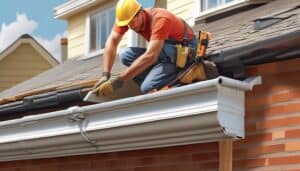While many homeowners focus on the larger aspects of home maintenance, the humble gutter often slips under the radar. Yet, these unassuming channels play a vital role in safeguarding your home from water damage by directing rainwater away from the foundation. However, gutters are not indestructible and require regular attention.
Several warning signs indicate that your gutters are nearing the end of their lifespan and need gutter replacement. Visible cracks, sagging gutters, and peeling paint near the gutter line are all red flags. Additionally, water stains on exterior walls are a clear indication that your gutters are no longer effectively diverting water. Recognizing these early indicators allows you to take proactive steps to protect your home from potential water damage.
Let’s delve deeper into specific signs to watch for when assessing the condition of your gutters.
Do Visible Cracks or Gaps in My Gutters Indicate a Need for Gutter Replacement?
Don’t let small cracks become big problems. If you notice any cracks or gaps in your gutters, it’s time to take action and do gutter replacement. These seemingly minor issues can quickly escalate into major headaches for your home.
Water is a powerful force, and when it finds a way through cracks in your gutters, it can cause significant damage. This moisture can seep into your home’s structure, leading to rot and weakening the foundation. Preventing these problems is much easier (and cheaper) than fixing them later.
Investing in new gutters is a smart move. Not only will it protect your home from costly water damage, but it can also improve your home’s appearance and even boost its value.
Does sagging or pulling gutters indicate a problem that requires repair or replacement?
Sagging gutters are a clear indicator that it’s time for a replacement. When gutters pull away from your home or start to droop, it’s a sign that they’re no longer functioning correctly and could be causing damage.
Why do gutters sag?
- Weak brackets: The brackets holding your gutters in place might be loose, broken, or inadequate.
- Clogged gutters: Excessive debris can weigh down gutters, causing them to sag.
- Age and wear: Over time, gutters can deteriorate and become less sturdy.
Don’t delay the replacement. Ignoring sagging gutters can lead to a host of problems, including water damage to your home’s foundation, basement, and exterior walls. Additionally, sagging gutters can cause erosion in your landscaping.
Protect your investment by addressing gutter issues promptly.
Why Is Peeling Paint or Rust a Problem?

Peeling paint and rust on your gutters are clear indicators of deterioration. The protective coating on your gutters is essential for their longevity, and once it starts to break down, the gutters become vulnerable to water damage, cracks, and rust.
Why is this a problem?
- Reduced functionality: Peeling paint and rust compromise the gutter’s ability to efficiently channel water away from your home.
- Water damage: Damaged gutters can lead to water pooling around your foundation, causing potential structural issues.
- Structural integrity: Rust weakens the gutter’s structure, increasing the risk of leaks and collapses.
Procrastinating on gutter repairs can lead to costly damage to your home’s exterior. It’s essential to address these issues promptly. Consider consulting a professional to assess the extent of the damage and recommend the best course of action, whether it’s repair or replacement.
What Are the Signs of Water Damage Marks?
Water stains on your home’s exterior are often a clear sign that your gutters aren’t doing their job. These unsightly marks can indicate underlying issues that, if left unchecked, can lead to more significant problems.
Key indicators that your gutters might need replacing due to water damage marks:
- Color changes: Discoloration on walls, roof edges, or downspouts can signal water runoff problems.
- Stains under gutters: Visible stains or discoloration directly below your gutters often indicate leaks or cracks.
- Overwhelmed gutters: Gutters that consistently overflow during heavy rain are not functioning properly.
Ignoring these signs can lead to costly repairs and potential structural damage. Regular gutter maintenance and prompt attention to these warning signs can save you time and money in the long run.
What Are the Indicators of Overflowing or Pooling Gutter Water?

Watermarks or discoloration under your gutters are clear indicators of a gutter problem. Ideally, rainwater should be efficiently channeled away from your home’s foundation through the gutters and downspouts. However, when gutters are clogged, damaged, or improperly installed, water can overflow, leading to potential damage.
Signs your gutters might need replacing:
- Water overflowing gutters: This is a clear sign of blockage or improper installation.
- No water in gutters: This could indicate a blockage or downspout issues.
- Puddles near foundation: Standing water near your home is a red flag.
- Sagging or tilting gutters: These issues prevent proper water flow.
- Deteriorated gutters: Old, worn-out gutters may not be able to handle the job.
Water accumulation around your home’s foundation can cause serious problems, including basement flooding, foundation cracks, and erosion. Addressing gutter issues promptly is essential to protect your home’s structural integrity.t and put your foundation at risk. Getting those gutters replaced sooner rather than later is a smart move to keep your property safe from these kinds of headaches.
Frequently Asked Questions
Conclusion
Alright, let’s break it down and keep it real.
If you’ve got cracks or gaps in your gutters, see them sagging or pulling away from the house, notice peeling paint or spots of rust or water stains, or if the gutters can’t handle the rain and it’s spilling over or pooling up, then it’s probably time to think about getting new gutters.
Letting these problems slide isn’t a good move because it can lead to leaks and mess up your house and its foundations. So, you want to get on top of these issues quickly to keep your home safe and sound.






